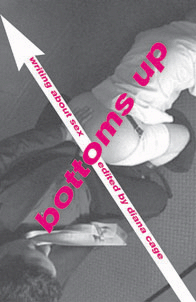Part Jane Austen, Part Henry Miller
Is boundary-pushing womens erotica really just about acting more like men?

Sex and Sensibility: 28 True Romances from the Lives of Single Women
Edited by Genevieve Field
Atria Books/Washington Square Press, $14.00
Bottoms Up: Writing About Sex
Edited by Diana Cage
Soft Skull Press, $14.00
If you want to see how much more sexually open women have become, just look at their erotica. Thirty years ago, a gal combing the public marketplace for sexually explicit fiction or memoir, for personal edification or plain entertainment, might well have come up short. The quality and quantity of goods just weren’t available. Making matters worse, she may have been embarrassed to do such shopping, as it would be openly admitting that she had such curiosities. Embroiled in the notorious “sex wars,” the feminist movement of the ’70s was hotly debating the issue, divided over whether pornography was inherently harmful to women or liberating.
But today, not only has this younger generation of women been reading erotic writing, they’ve emerged as influential producers of the work. Younger feminists have continued to enjoy freedom women were beginning to explore in the ’60s and ’70s, promoting women-centered pornography as a way to investigate and demystify women’s long-forbidden and repressed desires. In the mainstream population, too, younger women (who have felt for years comfortable about openly buying Cosmo and condoms in the drug store) don’t think twice about picking up a dirty book or two at Barnes & Noble. No dark glasses or plain brown paper wrappers needed.
Predictably, the market has responded: in the past decade women’s erotic fiction and memoir has exploded. In the first half of the 1990s alone, the numbers of such titles quadrupled. Reflecting women’s continuing shifts of sexual attitude, these books increasingly have defied traditional limits of the pastel-hued category of “erotica,” and,without apology, have headed right into the explicit, no-holds-barred territory of porn. Sex-positive lesbian and bisexual women took the lead with graphic magazines like On Our Backs and writings by Pat Califia, Susie Bright and Carol Queen (among many others). By 2000, women writing explicitly and raunchily about sex became an accepted feminist statement for queer and straight gal alike in anthologies like Gynomite: Fearless, Feminist Porn, edited by Liz Belile.
In the early 1990s, both the Herotica and Best American Erotica series took off as ongoing franchises. Lately the genre has only mushroomed, with ever-more-specific themes and new titles like Best Black Women’s Erotica, Best Bisexual Women’s Erotica, Zaftig: Well Rounded Erotica (all Cleis, 2001); Best Bondage Erotica (Cleis, 2003); Best Transgender Erotica (Circlet Press, 2002); and even, for Jewish women, The Oy of Sex (Cleis, 1999).
This season, two new sex anthologies continue this trend, exploring women’s growing willingness to be sexually assertive and to openly pursue their own pleasure (even in the red states). The witty and frank Sex and Sensibility: 28 True Romances from the Lives of Single Women is a collection of memoirs of mostly straight urban women telling “their best stories” about sex and singledom. It is edited by Genevieve Field, cofounder of the hipster/intellectual sex Web site Nerve.com.
The second–and more boundary-pushing, more focused–volume is Bottoms Up: Writing about Sex, a collection of fiction mostly by queer or “genderqueer” (gender not established) women, which more graphically and experimentally explores the mental terrain of sexual desire. Its boldness reflects the pro-sex sensibilities of Diana Cage, editor of both the anthology and of the trendsetting On Our Backs, as well as author of several lesbian sex guides.
In both of these new collections, women assume freedoms once reserved for men, both in high levels of expressed lust and experimentation and even in their use of language (gone is the demure coquette–these women say “fuck” a lot). They also spend considerable time enjoying and then getting burned by, the “bad boy” (or “bad girl”) type–you know, the kind that makes up all the examples of whom you should NOT date in the bestseller He’s Just Not that Into You. While the “rakes” (as Field calls them) described are probably, yes, just not into you, they do make for some interesting stories.
Wanna finish reading this essay? Visit our website at www.ruminator.com to find out where you can pick up a copy of Ruminator in your neighborhood!